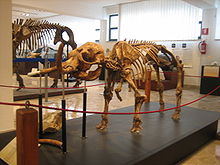Museo Geologico Gemmellaro
The Museo Geologico Gemmellaro is a geological and paleontological museum in Palermo . It is located at 131 Corso Tukory. It is attached to the University of Palermo and is a research and teaching institute. The Museo Gemmellaro is one of the most important institutions of its kind in the Mediterranean.
history
The institute began in 1838 as the natural history collection of the scientist Pietro Calcara (1819–1854).
In 1860, the Palermitan scientist Gaetano Giorgio Gemmellaro took over the collection and managed it until shortly before his death in 1904. Gemmellaro set about organizing the extensive natural history collections of Count Airoli in a cabinet in the immediate vicinity of the Theatiner's rooms on Via Maqueda, which he had bequeathed to the institute along with a substantial sum of money. Gemmellaro procured new showcases and cupboards and did his research tirelessly. He founded the geological stratigraphy , his special interest was the Sicilian dwarf elephant and various lava stones .
After Gemmellaro's departure in 1904, there were no more research activities and the collection was only enlarged. In 1941 parts of the collection were damaged in an earthquake , and a bombing raid in 1943 caused further damage. In 1965, the stocks were inadvertently stowed in boxes and stored in Via Calatafimi. Parts of the finds got completely mixed up. In 1970 the collections were moved to the current building on Via Tuckory. The new director Enzio Burgio resumed the research in 1975 and began again to rearrange the damaged and neglected finds. The research facility experienced an upswing. Burgio died in 2001.
exhibition
The collections are housed in four halls.
Sala Burgio . In the main hall there is an exhibition on the development of the continents and living beings. Maps show the migration of the continents over the course of the earth's history. In the showcases there are various fossils ( ammonites , fossilized shark teeth, etc.) from the beginnings of geological history to around the Tertiary .
Sala degli elefanti . Here you can see an extensive exhibition of skeletons and fossils of deceased higher mammals , such as elephants, bison and turtles . One of the highlights is the exhibition on the development of the elephants, which have since become extinct on this island and came to Sicily from Africa over a land bridge .
Sala dei Cristalli . Here are mineralogical specifics on display. The exhibition shows interesting pieces all over the world, but is particularly specialized in Sicilian rocks, such as B. lava rocks and calcites , which z. Some formed around six million years ago when the Mediterranean dried up. Highlights here are pieces of lava from Isola Ferdinandea , which Carlo Gemmellaro collected during the short period of its existence there, and a stone with an enclosed drop of seawater around six million years ago.
Sala del Uomo . Another exhibition deals with the development of the people and their culture on the island. Finds from the Grotta San Teodoro near Acquedolci ( Messina ) are shown here. These are the skeletons of four men and women, as well as stone instruments, bite marks on materials and a necklace with shark teeth , from which one can draw conclusions about the way of life and culture of these people. Here you can admire the oldest surviving skeleton of a Sicilian woman (approx. 11,000 years BC).
Since the premises are far too small for the extensive collections, the department has been looking for a more suitable location for years.
Web links
- Museo Gemmellaro on the University of Palermo website
Coordinates: 38 ° 6 ′ 31.7 " N , 13 ° 21 ′ 33.3" E

